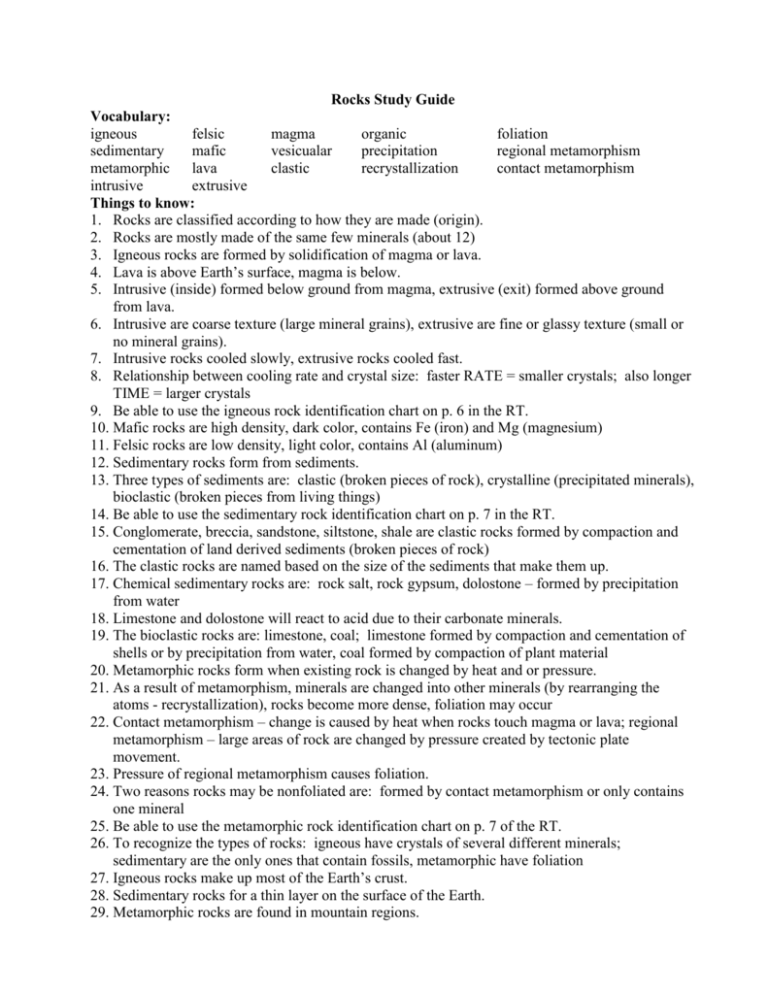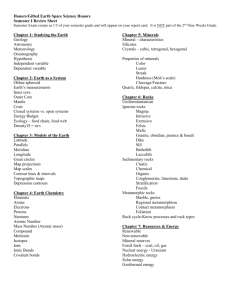Rocks Study Guide
advertisement

Rocks Study Guide Vocabulary: igneous felsic magma organic foliation sedimentary mafic vesicualar precipitation regional metamorphism metamorphic lava clastic recrystallization contact metamorphism intrusive extrusive Things to know: 1. Rocks are classified according to how they are made (origin). 2. Rocks are mostly made of the same few minerals (about 12) 3. Igneous rocks are formed by solidification of magma or lava. 4. Lava is above Earth’s surface, magma is below. 5. Intrusive (inside) formed below ground from magma, extrusive (exit) formed above ground from lava. 6. Intrusive are coarse texture (large mineral grains), extrusive are fine or glassy texture (small or no mineral grains). 7. Intrusive rocks cooled slowly, extrusive rocks cooled fast. 8. Relationship between cooling rate and crystal size: faster RATE = smaller crystals; also longer TIME = larger crystals 9. Be able to use the igneous rock identification chart on p. 6 in the RT. 10. Mafic rocks are high density, dark color, contains Fe (iron) and Mg (magnesium) 11. Felsic rocks are low density, light color, contains Al (aluminum) 12. Sedimentary rocks form from sediments. 13. Three types of sediments are: clastic (broken pieces of rock), crystalline (precipitated minerals), bioclastic (broken pieces from living things) 14. Be able to use the sedimentary rock identification chart on p. 7 in the RT. 15. Conglomerate, breccia, sandstone, siltstone, shale are clastic rocks formed by compaction and cementation of land derived sediments (broken pieces of rock) 16. The clastic rocks are named based on the size of the sediments that make them up. 17. Chemical sedimentary rocks are: rock salt, rock gypsum, dolostone – formed by precipitation from water 18. Limestone and dolostone will react to acid due to their carbonate minerals. 19. The bioclastic rocks are: limestone, coal; limestone formed by compaction and cementation of shells or by precipitation from water, coal formed by compaction of plant material 20. Metamorphic rocks form when existing rock is changed by heat and or pressure. 21. As a result of metamorphism, minerals are changed into other minerals (by rearranging the atoms - recrystallization), rocks become more dense, foliation may occur 22. Contact metamorphism – change is caused by heat when rocks touch magma or lava; regional metamorphism – large areas of rock are changed by pressure created by tectonic plate movement. 23. Pressure of regional metamorphism causes foliation. 24. Two reasons rocks may be nonfoliated are: formed by contact metamorphism or only contains one mineral 25. Be able to use the metamorphic rock identification chart on p. 7 of the RT. 26. To recognize the types of rocks: igneous have crystals of several different minerals; sedimentary are the only ones that contain fossils, metamorphic have foliation 27. Igneous rocks make up most of the Earth’s crust. 28. Sedimentary rocks for a thin layer on the surface of the Earth. 29. Metamorphic rocks are found in mountain regions.







